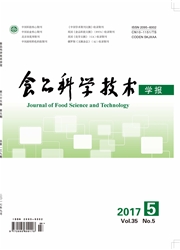

 中文摘要:
中文摘要:
将作为棕榈油分提副产物的棕榈油中间分提物(PMF)应用于软冰淇淋生产,通过对比分析棕榈油分提副产物中6种不同熔点(30-40)℃的PMF与4种代表性市售软冰淇淋预拌粉中油脂的理化性质、脂肪酸组成及固体脂肪含量(SFC)发现,熔点为37.2℃的PMF(PMF-3)在(0-10)℃和(26.7-33.3)℃SFC值变化比较缓慢,而在(10-26.7)℃SFC迅速下降,最适宜应用于软冰淇淋的生产,且其所含饱和脂肪酸与不饱脂肪酸比例接近1:1,主要脂肪酸为棕榈酸和油酸,这种脂肪酸组成使PMF-3较其他食用油具有更好的热稳定性。因此,研究选择PMF-3作为生产软冰淇淋用的油脂。通过L9(3-4)正交试验,对原料中PMF-3、脱脂乳粉、糖及麦芽糊精含量配比进行优化,结合感官评价分析,发现PMF-3的添加量为8%,脱脂乳粉的添加量为8%,麦芽糊精的添加量为1%,白砂糖的添加量为12%时生产的软冰淇淋硬度最适中,口感最佳。
 英文摘要:
英文摘要:
Palm mid fraction(PMF) as a by-product of palm oil was applied in the producing of soft ice cream. The physical and chemical properties, fatty acid composition and solid fat content(SFC) of six PMF with different melting points(30-40)℃ and the oils extracted from four representative commercial soft ice cream mixes were compared. The results showed that the SFC of PMF with melting point of 37.2 ℃(PMF-3) changed slowly with the temperature range from 0 ℃ to 10 ℃ and from 26.7 ℃ to 33.3 ℃, and decreased rapidly with the temperature range from 10 ℃ to 26.7 ℃, indicating PMF-3 was appropriate for the production of soft ice cream. Meanwhile, the ratio between saturated fatty acid and unsaturated fatty acids in PMF-3 was close to 1:1, and the main fatty acid in PMF-3 was palmitic acid and oleic acid which made PMF-3 had better thermal stability than other edible oils. Therefore, PMF-3 was chosen in this study. Based on the L9(3-4) orthogonal test and sensory evaluation, the PMF-3-based soft ice cream with moderate hardness and best taste was obtained by adding 8% PMF-3, 8% skimmed milk powder, 1% maltodextrinand 12% sugar.
 同期刊论文项目
同期刊论文项目
 同项目期刊论文
同项目期刊论文
 期刊信息
期刊信息
